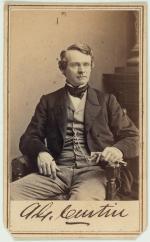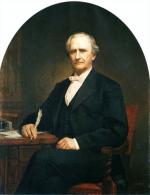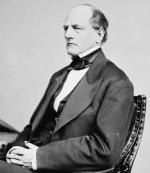![header=[Marker Text] body=[Governor of Pennsylvania, 1861-67, was born on this site. He brought about the establishment of State Normal Schools; organized the famed Pennsylvania Reserve Corps; obtained funds for the erection of State Orphan Schools. ] sign](kora/files/1/10/1-A-12A-139-ExplorePAHistory-a0a4l9-a_450.gif)
Mouse over for marker text
Name:
Andrew G. Curtin
Region:
Valleys of the Susquehanna
County:
Centre
Marker Location:
Allegheny St. at Cherry Lane, Bellefonte
Dedication Date:
October 9, 1950
Behind the Marker
Andrew Gregg Curtin was born into wealth and power on April 22, 1815, in Bellefonte, PA. His father Roland ran a successful an iron foundry and his mother, Jane Gregg, was the daughter of a United States senator Andrew Gregg, Curtin’s namesake. After attending the Milton Academy, Curtin studied law at Dickinson School of Law in Carlisle, then practiced law in Bellefonte after his admission to the bar in 1837.
Curtin first ventured into politics in 1840, campaigning in favor of Whig presidential candidate, William Henry Harrison. In the years that followed he developed a reputation for the speeches he delivered on behalf of Whig candidates throughout the state, including John Pollock, who won the gubernatorial election in 1854. In 1855 Pollock appointed Curtin served as state Superintendent of Public Instruction and established the state system of “normal” schools for training teachers.
In 1860 Curtin helped persuade Pennsylvania’s delegates at the National Republican Convention to abandon the nomination of his political nemesis, Pennsylvania Senator Simon Cameron, and instead cast their votes in-favor of Lincoln, making Pennsylvania a key swing state in his successful nomination. That fall, Curtin won Pennsylvania’s 1860 gubernatorial election, becoming the first Republican to hold this office.
Simon Cameron, and instead cast their votes in-favor of Lincoln, making Pennsylvania a key swing state in his successful nomination. That fall, Curtin won Pennsylvania’s 1860 gubernatorial election, becoming the first Republican to hold this office.
From the onset of the Civil War, Governor Curtin committed Pennsylvania to the Union cause, successfully mobilizing troops and the state’s resources. Curtin began enlisting volunteers immediately after the first shots were fired at Fort Sumter. Within three days, a training camp, Camp Curtin, opened near the state capitol building in Harrisburg. Following the disaster at the Battle of Bull Run in July 1861, Curtin sent the Pennsylvania Reserve Volunteer Corps to Washington, D.C. to protect the nation’s now vulnerable capital.
Camp Curtin, opened near the state capitol building in Harrisburg. Following the disaster at the Battle of Bull Run in July 1861, Curtin sent the Pennsylvania Reserve Volunteer Corps to Washington, D.C. to protect the nation’s now vulnerable capital.
Following a series of harrowing military defeats, northern support for the war was wavering. In hopes of bolstering support for Lincoln, Curtin on September 24-25, 1862, hosted the Conference for Governors of the Loyal States at the Logan House in Altoona. Here, the governors of the fourteen northern states passed a series of resolutions supporting the emancipation of slavery, the dismissal of General George B. McClellan, and the mustering of 300,000 more troops. By issuing these resolutions, the governors re-affirmed their support of Lincoln and the Union cause, and strengthened Lincoln’s presidency by protecting him from sole responsibility for potentially unpopular decisions, including the drafting of more soldiers.
Conference for Governors of the Loyal States at the Logan House in Altoona. Here, the governors of the fourteen northern states passed a series of resolutions supporting the emancipation of slavery, the dismissal of General George B. McClellan, and the mustering of 300,000 more troops. By issuing these resolutions, the governors re-affirmed their support of Lincoln and the Union cause, and strengthened Lincoln’s presidency by protecting him from sole responsibility for potentially unpopular decisions, including the drafting of more soldiers.
Curtin spent much of the war in very poor health. The stress of the war caused him to experience serious illness and a virtual breakdown during his first term in office. After his reelection in 1863, defeating Democrat George Woodward by about fifteen thousand votes, Curtin’s health was so poor that there was widespread speculation he would leave office. The governor, however, stubbornly soldiered on, earning respect as the "Soldiers' Friend" for his continued efforts to improve supplies, transport, support personnel, and the care of troops in the field. After the close of the war, Curtin also established a system of state schools for war orphans.
After leaving the governor’s office in 1867, Curtin lost the Republican nomination for the election to the United States Senate to his old nemesis Simon Cameron, then served as United States Minister to Russia from 1869 to 1872. Disillusioned with the corruption of the Grant administration he became a Democrat in 1872, and ended his political career by serving three terms as a Democrat in the U.S. House of Representatives, from 1881-1887. Upon retirement, he returned to Bellefonte where he died in 1894.
As governor of Pennsylvania during the Civil War, Andrew Curtin emerged as one of President Lincoln’s staunchest supporters. Under his leadership more than 360,000 Pennsylvanians served in the Union Army, more than any other state than New York, and the state mobilized its industries and formidable economic resources in support of the war.
We have, during the past year, made mighty strides toward such a solution, and to all human appearance we approach its completion. But whatever reverses may happen—whatever blood and treasure may still be required—whatever sacrifices may be necessary—there will remain the inexorable determination of our people to fight out this thing to the end—to preserve and perpetuate this Union. They have sworn that not one star shall be reft from the constellation, nor its clustered brightness be dimmed by treason and savagery, and  they will keep their oath.
they will keep their oath.
Governor Andrew G. Curtin, January 7, 1864.
Governor Andrew G. Curtin, January 7, 1864.
Andrew Gregg Curtin was born into wealth and power on April 22, 1815, in Bellefonte, PA. His father Roland ran a successful an iron foundry and his mother, Jane Gregg, was the daughter of a United States senator Andrew Gregg, Curtin’s namesake. After attending the Milton Academy, Curtin studied law at Dickinson School of Law in Carlisle, then practiced law in Bellefonte after his admission to the bar in 1837.
Curtin first ventured into politics in 1840, campaigning in favor of Whig presidential candidate, William Henry Harrison. In the years that followed he developed a reputation for the speeches he delivered on behalf of Whig candidates throughout the state, including John Pollock, who won the gubernatorial election in 1854. In 1855 Pollock appointed Curtin served as state Superintendent of Public Instruction and established the state system of “normal” schools for training teachers.
In 1860 Curtin helped persuade Pennsylvania’s delegates at the National Republican Convention to abandon the nomination of his political nemesis, Pennsylvania Senator
From the onset of the Civil War, Governor Curtin committed Pennsylvania to the Union cause, successfully mobilizing troops and the state’s resources. Curtin began enlisting volunteers immediately after the first shots were fired at Fort Sumter. Within three days, a training camp,
Following a series of harrowing military defeats, northern support for the war was wavering. In hopes of bolstering support for Lincoln, Curtin on September 24-25, 1862, hosted the
Curtin spent much of the war in very poor health. The stress of the war caused him to experience serious illness and a virtual breakdown during his first term in office. After his reelection in 1863, defeating Democrat George Woodward by about fifteen thousand votes, Curtin’s health was so poor that there was widespread speculation he would leave office. The governor, however, stubbornly soldiered on, earning respect as the "Soldiers' Friend" for his continued efforts to improve supplies, transport, support personnel, and the care of troops in the field. After the close of the war, Curtin also established a system of state schools for war orphans.
After leaving the governor’s office in 1867, Curtin lost the Republican nomination for the election to the United States Senate to his old nemesis Simon Cameron, then served as United States Minister to Russia from 1869 to 1872. Disillusioned with the corruption of the Grant administration he became a Democrat in 1872, and ended his political career by serving three terms as a Democrat in the U.S. House of Representatives, from 1881-1887. Upon retirement, he returned to Bellefonte where he died in 1894.
As governor of Pennsylvania during the Civil War, Andrew Curtin emerged as one of President Lincoln’s staunchest supporters. Under his leadership more than 360,000 Pennsylvanians served in the Union Army, more than any other state than New York, and the state mobilized its industries and formidable economic resources in support of the war.








